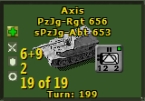Curtis Lemay
Posts: 12969
Joined: 9/17/2004
From: Houston, TX
Status: offline

|
I'm left wondering if this guy has ever wargamed. If not, that's a shame, since that the venue that clearly shows he's wrong. We need only ask ourselves whether Tactical Wargames fundamentally differ from Operational ones, and whether Operational ones fundamentally differ from Strategic ones. The answer to both questions is an unqualified "Yes".
Tactical wargames have hex-scales in meters, unit sizes of platoon or below, and time scales in minutes or less. They are concerned with tactical issues like line-of-sight, opportunity fire, facing, formations, rally, covering fire, and direct-fire weapon ranges. The fundamental objective is to maneuver the forces you have at hand into the best locations to kill the enemy, without themselves being killed. That rarely involves concentrating them. Instead the focus is much more on vantage points, and concealment.
Operational wargames have hex-scales in kilometers, unit sizes of company or above, and time scales in hours or more. Their manuevers are primarily concerned with getting the material in place to enable battles to be won by their tactical sub-commanders - and denying that material edge to their enemies. That usually entails concentrating force at the point of attack.
Strategic wargames have hex-scales in hundreds of kilometers, unit sizes of army or above, and time scales in weeks or more. They are primarily concerned with production, economics, politics, and assignment of force to different theaters of operation. Maneuver isn't a consideration at all.
Clearly, players are making tactical decisions in tactical games, operational decisions in operational games, and strategic decisions in strategic games.
Now, of course, a tactical game can have a large enough scope to encompass operational factors, just as an operational game can have a large enough scope to encompass strategic factors. That doesn't change their fundamental differences.
And having features that superficially appear to be the same (envelopment, for example) doesn't mean that they are the same. Tactically, surrounding an enemy is useful to triangulate them - so there is no way for them to be "behind" anything. If you're triangulated, you'll be exposed to at least one of the three angles. That's not true operationally. There the advantage is to deny reinforcement, resupply, and escape.
|
 Printable Version
Printable Version












 Dutch
Dutch



 New Messages
New Messages No New Messages
No New Messages Hot Topic w/ New Messages
Hot Topic w/ New Messages Hot Topic w/o New Messages
Hot Topic w/o New Messages Locked w/ New Messages
Locked w/ New Messages Locked w/o New Messages
Locked w/o New Messages Post New Thread
Post New Thread